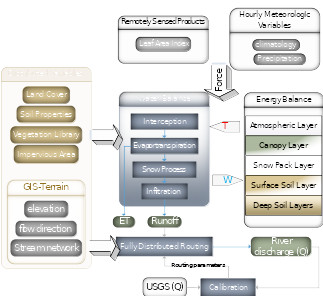Background
CREST-SVAS is a computationally efficient, fully distributed hydrological model designed to simulate flow discharges for large watersheds at a fine spatiotemporal resolution (30 m to 1 km spatial grid resolution and hourly time steps). CREST-SVAS integrates a runoff generation module to simulate vertical water and energy fluxes with a routing module to simulate channel discharge. The runoff generation model physically couples energy and water balances. It takes meteorological fields, land cover, distributed soil, vegetation and terrain properties as input variables. Due to its strong physical basis and computational efficiency, It can produce long-term, high-resolution hydrological simulations at various basin scales and types.
Objective
The work presented here focuses on providing water cycle variables for groundwater and crop yield models running in the Lake Tana region, including evapotranspiration (ET), soil moisture and stream flow. The CREST-SVAS model (Shen and Anagnostou 2017) can be further used to explore climate variability impacts on agriculture, hydrology and provide guidance to governments and development agencies for more efficient management of the water resources of this important region.
Initial Results
Initial validation results show that CREST estimated soil moisture well captured the Satellite ET product (MODIS) at grid and daily scale with a Nash-Sutcliffe efficiency (NSCE) being and relative bias being . Simulation and validation of soil moisture and stream flow are still under investigation.

Figure 1. CREST Framework
Dissemination
Shen, X., Anagnostou, E., 2017. A Framework to Improve Hyper-Resolution Hydrologic Simulation in Snow-Affected Regions”, Journal of Hydrology, vol.552, pp.1-12, DOI:10.1016/j.jhydrol.2017.05.048.
Research Team
Xinyi Shen, Assistant Research Professor of Civil and Environmental Engineering, University of Connecticut.
Rehenuma Lazin, Graduate Student, Civil and Environmental Engineering, University of Connecticut.
Emmanouil N. Anagnostou, Professor of Civil and Environmental Engineering, University of Connecticut.